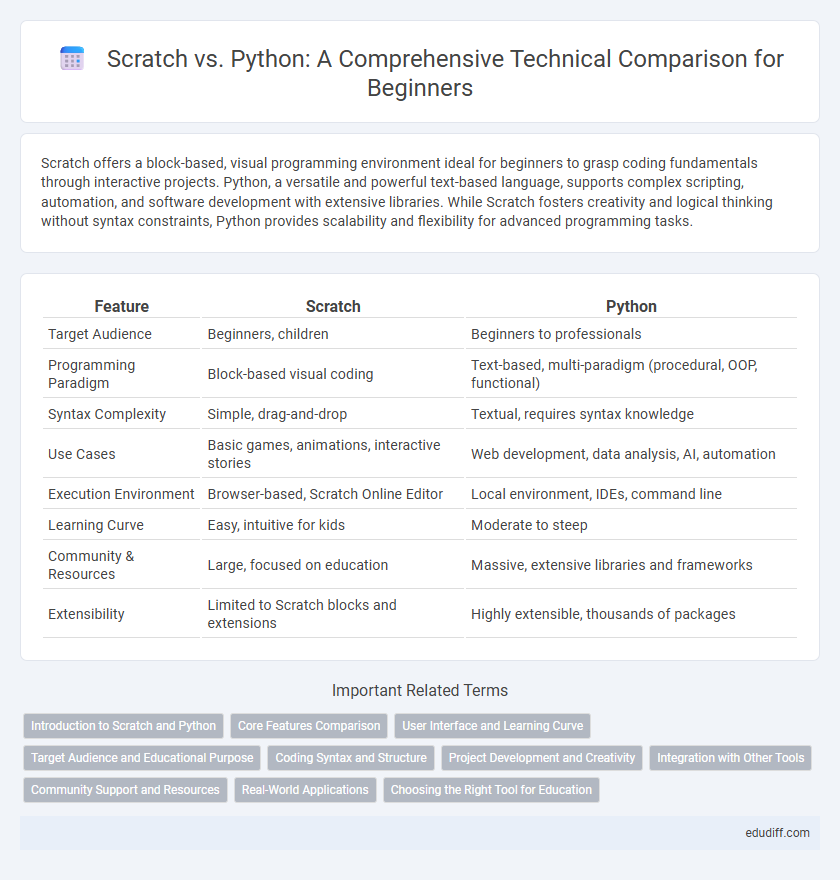Scratch offers a block-based, visual programming environment ideal for beginners to grasp coding fundamentals through interactive projects. Python, a versatile and powerful text-based language, supports complex scripting, automation, and software development with extensive libraries. While Scratch fosters creativity and logical thinking without syntax constraints, Python provides scalability and flexibility for advanced programming tasks.
Table of Comparison
| Feature | Scratch | Python |
|---|---|---|
| Target Audience | Beginners, children | Beginners to professionals |
| Programming Paradigm | Block-based visual coding | Text-based, multi-paradigm (procedural, OOP, functional) |
| Syntax Complexity | Simple, drag-and-drop | Textual, requires syntax knowledge |
| Use Cases | Basic games, animations, interactive stories | Web development, data analysis, AI, automation |
| Execution Environment | Browser-based, Scratch Online Editor | Local environment, IDEs, command line |
| Learning Curve | Easy, intuitive for kids | Moderate to steep |
| Community & Resources | Large, focused on education | Massive, extensive libraries and frameworks |
| Extensibility | Limited to Scratch blocks and extensions | Highly extensible, thousands of packages |
Introduction to Scratch and Python
Scratch offers a visual, block-based programming environment designed for beginners to grasp coding fundamentals through interactive storytelling and animation. Python is a versatile, high-level programming language known for its readable syntax and extensive libraries, suitable for web development, data analysis, and automation. Both tools serve as effective entry points to programming, with Scratch emphasizing simplicity and Python providing scalability.
Core Features Comparison
Scratch offers a visual, block-based programming environment ideal for beginners and educational settings, emphasizing drag-and-drop coding and immediate feedback. Python provides a text-based, versatile syntax suited for advanced programming tasks, supporting extensive libraries and frameworks across various domains like web development, data science, and automation. The core difference lies in Scratch's simplicity and interactive design compared to Python's depth, scalability, and wide application in professional software development.
User Interface and Learning Curve
Scratch features a block-based visual user interface specifically designed for beginners, enabling simple drag-and-drop coding that reduces syntax errors and accelerates initial learning. Python offers a text-based interface with more complex syntax, promoting a steeper learning curve but greater flexibility for advanced programming concepts. Users transitioning from Scratch to Python may experience increased challenges due to Python's requirement for precise code structure and deeper understanding of programming logic.
Target Audience and Educational Purpose
Scratch targets young learners and beginners, offering a visual programming environment designed to introduce fundamental coding concepts through drag-and-drop blocks. Python caters to intermediate and advanced learners, emphasizing text-based coding suitable for developing real-world applications and enhancing problem-solving skills. Both languages serve educational purposes by progressively building computational thinking and programming expertise aligned with learner proficiency levels.
Coding Syntax and Structure
Scratch employs a block-based coding syntax designed for visual drag-and-drop assembly, making it accessible for beginners by eliminating syntax errors through predefined code blocks. In contrast, Python uses a text-based syntax characterized by indentation and concise keywords, enabling more complex and flexible programming paradigms. The structural difference between Scratch's graphical interface and Python's linear code lines impacts code readability, error handling, and scalability in software development projects.
Project Development and Creativity
Scratch's visual interface enables rapid project development and encourages creativity by allowing users to experiment with code blocks, making it ideal for beginners and educational settings. Python supports more complex project development through its extensive libraries and scalability, promoting advanced creativity in software design, data analysis, and automation. Both languages facilitate iterative development, but Python offers greater flexibility and power for professional-level projects.
Integration with Other Tools
Scratch offers limited integration capabilities primarily suited for educational environments, supporting extensions like LEGO Mindstorms and micro:bit for basic hardware control. Python excels in tool integration, with extensive libraries and APIs enabling seamless interaction with web services, databases, and hardware devices. Development frameworks such as Django for web applications and TensorFlow for machine learning showcase Python's versatility in complex system integration beyond simple programming tasks.
Community Support and Resources
Python offers extensive community support with a vast network of developers contributing to libraries, forums, and tutorials, facilitating continuous learning and problem-solving. Scratch benefits from a strong educational community tailored for beginners, featuring user-friendly forums, project sharing, and interactive resources designed to foster creativity in programming. Both platforms provide valuable resources, but Python's broader industry adoption ensures more comprehensive professional support and advanced development tools.
Real-World Applications
Scratch offers an intuitive interface ideal for beginners learning programming concepts, primarily used in education and simple game development. Python excels in real-world applications such as web development, data analysis, artificial intelligence, machine learning, and automation due to its extensive libraries and versatility. Enterprises and developers prefer Python for building scalable software solutions and complex algorithms that drive innovation across industries.
Choosing the Right Tool for Education
Scratch offers an intuitive, block-based interface ideal for introducing programming concepts to beginners, fostering creativity and logical thinking without syntax errors. Python provides a more versatile, text-based environment suitable for advanced learners aiming to develop real-world applications, supporting extensive libraries and frameworks. Selecting the right tool depends on the learner's age, experience level, and educational goals, balancing simplicity with scalability in coding skills.
Scratch vs Python Infographic

 edudiff.com
edudiff.com